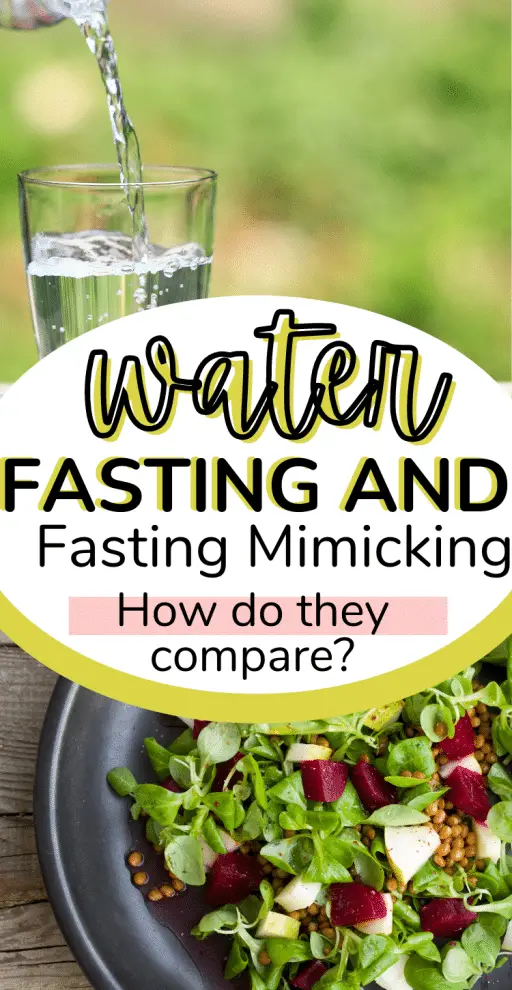Would you like to reduce inflammation and heal your gut simply by eating fewer but better-quality foods? In this post, we will talk about how the fast-mimicking diet compares to water fasting and how you can benefit from autophagy and still eat some food.
Fast Mimicking Diet Cheat Sheet
Before we get started with comparing the fast-mimicking diet with water fasting, let’s do a quick recap of the fast-mimicking diet principles.
- You need to eat only plant-based foods for the duration of the fast.
- You need to keep track of your calories and your macros.
- On day one, you will eat more (about 5-7 calories per lb of body weight). So, if you weigh 150 pounds (68 kg), you can eat 750-1050 calories). This amounts to about 26 grams of protein, 65 grams of fat, and 94 grams of carbs on your first day.
- On days 2-5, you need to keep your calories under 3-5 calories of body weight (so, again, if you weigh 150 pounds, that means you can consume 450-750 calories daily). If you have a fast metabolism, go for the higher end of the range. If you have a slower metabolism and you don’t need as many calories on an average day, for the lower end.
- Your macros should be about 10% protein, 56% fat, and 34% carbs on day one and 9% protein, 44% fat, and 47% carbs on the other days.
- Proteins provide about 4 calories per gram, so you will eat about 18 grams of protein daily (the total number of calories from protein will be around 80).
- Carbs provide about 4 calories per gram as well, so you will eat about 65-94 grams of carbs daily (around 270-376 calories).
- Fats provide about 9 calories per gram. You will consume about 39 grams of fat daily (around 352 calories).
- Most would consider it safe to exceed the amount of fat in these ratios but recommend not to exceed the amounts of protein and carbs.
And here’s your fast-mimicking diet cheat sheet. If you need more info, read my post Modified Fasting: How You Can Benefit From Fasting Without Starving.

Fasting Benefits
If you are reading this, you probably know a bit about how fasting benefits your body. I still want to explain how it works so we can jump right into our fast-mimicking diet vs. water-fasting comparison.
How Does Fasting Work?
Fasting is one of the ways you can trigger autophagy. Autophagy is a natural healing process through which your body replaces damaged cells with new ones. The word autophagy comes from the Greek words “auto,” which means “self,” and “phagein,” which means “eat.” You can read my post What Is Autophagy and How to Induce It to gain a better understanding of how the process works, but here are the basics:
- Autophagy happens in response to stresses like fewer carbs, less protein, exercise, and fewer calories.
- The benefits of autophagy encompass reduced cancer cell growth, reduced neurodegenerative diseases, and improved immune function.
- More autophagy isn’t always better.
When you fast, your body runs out of glycogen, so it needs to break down stored fat for energy. This is when you achieve ketosis. This seems to be the main mechanism behind how fasting induces autophagy.

How Long Do You Need to Fast to Induce Autophagy?
There is no black-and-white answer to this question. It will vary depending on the individual. Measuring your ketones is a good way to check if you are in “autophagy” mode. As I mentioned, fasting depletes glycogen stores, and your body produces ketones using fat cells. With experience, you will feel the difference when you experience ketosis. However, you may find a ketone monitor helpful at first.
I use the Keto Mojo. You can use my affiliate link to get a 15 percent discount.

I know from experience that I am officially in ketosis at around the 18-hour fast when I fast. That’s one of the reasons I like to recommend at least a few 20-hour fasts each week. I also read the following:
Animal studies have shown evidence of autophagy after 24 hours of fasting, which starts peaking at around 48 hours of fasting.
MedicineNet
Autophagy Timeline
Plus, I created this autophagy timeline when I researched the topic a while back and wrote my post How Long Should You Fast For Maximum Benefits?
- 12 hours: Ketone production may start. Ketones reduce inflammation and improve cognitive function. You may measure your ketones using a ketone monitor (check out the Keto Mojo using my affiliate link and get a 15% discount).
- 18 hours: You most likely have exhausted your glycogen stores and have entered the fat-burning mode. You are producing more ketones.
- 24 hours: Significant autophagy is happening. Your body is breaking down some proteins linked to neurodegenerative diseases and is starting to repair itself. Furthermore, you will start experiencing some intestinal cell regeneration at this point.
- 48 hours: Your growth hormone level (GH) is five times higher than when you started your fast. Growth hormones preserve lean muscle and reduce fat accumulation.
- 72 hours: Your body breaks down old immune cells and produces new ones.

Fast Mimicking Diet Vs. Water Fasting
So here we go. That’s, in part, why I love the fasting-mimicking diet. As you can see, fasting for 3-5 days provides deeper autophagy. However, many (including me) will find going this long without food is almost impossible. Going five days with fewer calories seems a lot more doable. Is it as effective, though? Let’s look into it.
Could the Fast Mimicking Diet Be Better Than Water Fasting?
As far as I know, Dr. Valter Longo (creator of the Fasting Mimicking Diet) is the only scientist to have compared modified dating and water fasting in the context of animal studies.
Dr. Valter Longo conducted studies on mice with Inflammatory Bowel Disease (IBD).
The study analyzed the evolution in intestinal inflammation after 2 cycles of the FMD, each cycle lasting 4 days and then followed by a normal diet.
The conclusion was that the Fasting Mimicking Diet (FMD) cycles were more effective than only water fasting.

Modified Fasting and Gut Health
I call the Fasting Mimicking Diet modified fasting because Fasting Mimicking Diet is Dr. Valter Logo’s trademark name for his protocol. Moreover, the Fasting Mimicking Diet is a modified fast. You fast by limiting your calories and following a specific macronutrient ratio rather than avoiding food completely.
Anyway, Dr. Valter Longo found that the FMD cycles cause an increase in good gut bacteria like Lactobacillaceae and Bifidobacteriaceae. Since gut health affects everything else, this is an important finding.
Modified Fasting and Inflammation
One way inflammation is measured by measuring your C-Reactive protein, an inflammation marker. Again, modified fasting seems more effective at decreasing inflammation markers than water fasting. The theory behind these observations is that the stress of the fast-mimicking diet is sufficient to induce autophagy, but the nutrients in the eating plans allow for greater healing.
DIY Fasting Mimicking Diet
Dr. Valter Longo doesn’t recommend you attempt creating your Fasting Mimicking Diet meal plan. He recommends the Prolon Kit, which contains all the foods you need for the 5-day fast.

However, I have experienced incredible results with my DIY meal plans. Read I Went on the Fasting Mimicking Diet and This Is What Happened to see my Before and After Pictures.
Fasting Mimicking Diet Meal Plans
Here’s a collection of the meal plan posts to help you get started:
- Easy 5-Day Detox to Balance Your Hormones and Lose Weight
- The Easiest and Simplest Meal Plan Ever For Your Modified Fast
- My DIY Fasting Mimicking Diet Plan
- Fasting Mimicking Diet Meal Plan and Recipes
- 5 Prolon-Inspired Soup Recipes for a Modified Fast
Lastly, I provide a full meal plan, recipe book, and Excel spreadsheet in my 30-Day Intermittent Fasting Transformation Program. If losing weight is one of your health goals, I recommend you check it out.

Fasting Mimicking Diet Vs. Water Fasting Video
In Summary
When looking at the fast-mimicking diet vs. water fasting, it looks like it has the edge because it is more doable and heals IBD in reducing inflammation than just water fasting. No more excuses! Anyone can manage a 5-day modified fast! How do I know? Because I managed it, and it changed my life.





